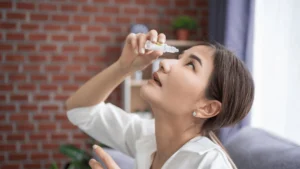Various Treatment Options for Dry Eye Discharge: Know Everything to Know About It
Introduction
Dry eye discharge, also known as ocular discharge, can be a bothersome condition that affects a person’s vision and overall eye health. It is characterized by a lack of moisture on the surface of the eye, resulting in uncomfortable symptoms such as redness, itching, and a gritty sensation. Understanding the causes, tear film, amount of discharge, and available treatments can help individuals effectively manage this condition and restore clarity and comfort to their eyes.

Causes
Dry eye discharge can be caused by various factors, including environmental conditions, such as dry air or strong winds, which increase evaporation of tears. Aging is another common cause, as tear production naturally decreases with age. Hormonal changes, such as menopause or pregnancy, can also contribute to this condition. Certain medications, like antihistamines and antidepressants, may produce dry eye symptoms as a side effect. Additionally, underlying health conditions such as diabetes, rheumatoid arthritis, and thyroid disorders can contribute to dry eye discharge.
Tear Film
The tear film is essential for maintaining the health and lubrication of the eyes. It consists of three layers: the mucin layer, aqueous layer, and lipid layer. The mucin layer acts as a foundation, ensuring the tear film evenly spreads across the ocular surface. The aqueous layer provides moisture and nutrients to the cornea and conjunctiva, while the lipid layer functions as a protective barrier, reducing tear evaporation. Each layer plays a crucial role in preventing dry eye discharge, and any disruption in this delicate balance can lead to symptoms of dryness and discomfort.
Amount of Discharge
The amount of discharge experienced in dry eye conditions can vary from person to person. Some individuals may notice a sticky or crusty discharge that accumulates along the eyelashes, while others may experience excessive watery discharge, paradoxically caused by the dryness and irritation. Both scenarios indicate an underlying imbalance in the tear film and should be addressed promptly to prevent further complications. It is vital to identify and understand the specific nature and volume of eye discharge to determine the most suitable treatment options.
Treatments
There are several treatment options available to manage dry eye discharge effectively. These can include: – Artificial tears: Over-the-counter lubricating eye drops can provide temporary relief by replacing the natural moisture in the eyes. – Prescription medications: Your eye care professional may prescribe medications such as anti-inflammatory drops or cyclosporine to alleviate dry eye symptoms. – Punctal plugs: These tiny silicone or gel plugs inserted into the tear ducts help to increase tear retention on the surface of the eye. – Warm compresses: Applying a warm compress to the eyes can help to loosen clogged oil glands and improve tear production. – Lifestyle changes: Simple adjustments like using a humidifier, avoiding dry environments, and taking regular screen breaks can significantly reduce dry eye symptoms.
When to Seek Doctor Help
While occasional dry eye discharge can be managed independently, it is essential to seek professional help when symptoms persist or worsen. Consult an eye doctor if you experience severe pain, vision changes, or if the discharge appears thick, colored, or accompanied by fever. Moreover, if self-care measures and over-the-counter treatments fail to provide relief, a comprehensive eye examination can help identify any underlying issues and guide you towards more specialized treatment options.
Summary
Dry eye discharge can negatively impact daily life and eye health. Understanding the causes, tear film layers, and the amount of discharge is crucial for effective management. Treatment options range from artificial tears to prescription medications, warm compresses, punctal plugs, and lifestyle changes. If symptoms persist or worsen, seeking professional help is recommended. By proactively addressing dry eye discharge, individuals can restore comfort and maintain clear vision for their enhanced quality of life.